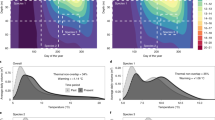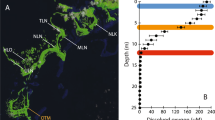Abstract
As environmental temperatures continue to rise and organisms experience novel and potentially lethal conditions1,2,3,4,5, the possibility of increased mass mortality events for animal populations appears likely1,6. Yet, due to die-off rarity and unpredictability, there have been few large-scale attempts to quantify the relationship between mass die-offs and local environmental temperatures. Here, we address this issue by analysing a database of 502 freshwater fish die-offs combined with lake-specific temperature profiles simulated for north temperate lake ecosystems. Die-offs driven by extreme summer conditions occurred disproportionately in lakes with warmer average surface temperatures and during periods of extreme heat. In contrast, we observed no relationships between current thermal extremes and die-offs attributed to infectious disease or winter environmental conditions. We forecast fish die-offs driven by summer environmental conditions to double by mid-century for north temperate lakes (2041–2059) and to increase more than fourfold by late century (2081–2099), particularly at southern latitudes. These results expose a direct link between novel temperature regimes and the increased probability of catastrophic ecological events in freshwater ecosystems.
This is a preview of subscription content, access via your institution
Access options
Access Nature and 54 other Nature Portfolio journals
Get Nature+, our best-value online-access subscription
$29.99 / 30 days
cancel any time
Subscribe to this journal
Receive 12 print issues and online access
$209.00 per year
only $17.42 per issue
Buy this article
- Purchase on Springer Link
- Instant access to full article PDF
Prices may be subject to local taxes which are calculated during checkout



Similar content being viewed by others
Data availability
All data that support the findings of this study, including R scripts, are available at https://github.com/andrewpbray/fish_MMEs_and_thermal_extremes and will be appropriately archived following the publication of this manuscript. All demographic and environmental datasets are available from public sources as referenced.
References
Buckley, L. B. & Huey, R. B. Temperature extremes: geographic patterns, recent changes, and implications for organismal vulnerabilities. Glob. Chang. Biol. 22, 3829–3842 (2016).
O’Reilly, C. M. et al. Rapid and highly variable warming of lake surface waters around the globe. Geophys. Res. Lett. 42, 10,773–10,781 (2015).
Wijffels, S., Roemmich, D., Monselesan, D., Church, J. & Gilson, J. Ocean temperatures chronicle the ongoing warming of earth. Nat. Clim. Chang. 6, 116–118 (2016).
Vasseur, D. A. et al. Increased temperature variation poses a greater risk to species than climate warming. Proc. R. Soc. Lond. B 281, 20132612 (2014).
Bolt, B., van der, Nes, E. H., van, Bathiany, S., Vollebregt, M. E. & Scheffer, M. Climate reddening increases the chance of critical transitions. Nat. Clim. Chang. 8, 478 (2018).
Moreno, J. & Møller, A. P. Extreme climatic events in relation to global change and their impact on life histories. Curr. Zool. 57, 375–389 (2011).
Williamson, C. E., Dodds, W., Kratz, T. K. & Palmer, M. A. Lakes and streams as sentinels of environmental change in terrestrial and atmospheric processes. Front. Ecol. Environ. 6, 247–254 (2008).
Gunderson, A. R., Tsukimura, B. & Stillman, J. H. Indirect effects of global change: from physiological and behavioral mechanisms to ecological consequences. Integr. Comp. Biol. 57, 48–54 (2017).
Hoffmann, A. A. & Sgrò, C. M. Comparative studies of critical physiological limits and vulnerability to environmental extremes in small ectotherms: how much environmental control is needed? Integr. Zool. 13, 355–371 (2017).
Zscheischler, J. et al. Future climate risk from compound events. Nat. Clim. Chang. 8, 469 (2018).
Magnuson, J. J., Beckel, A. L., Mills, K. & Brandt, S. B. Surviving winter hypoxia: behavioral adaptations of fishes in a northern Wisconsin winterkill lake. Environ. Biol. Fish. 14, 241–250 (1985).
Hansen, G., Read, J., Hansen, J. & Winslow, L. Projected shifts in fish species dominance in Wisconsin lakes under climate change. Glob. Chang. Biol. 23, 1463–1476 (2017).
Kock, R. A. et al. Saigas on the brink: multidisciplinary analysis of the factors influencing mass mortality events. Sci. Adv. 4, eaao2314 (2018).
Polsenaere, P. et al. Potential environmental drivers of a regional blue mussel mass mortality event (winter of 2014, Breton Sound, France). J. Sea Res. 123, 39–50 (2017).
Baylis, A. M. M. et al. Disentangling the cause of a catastrophic population decline in a large marine mammal. Ecology 96, 2834–2847 (2015).
Starr, M. et al. Multispecies mass mortality of marine fauna linked to a toxic dinoflagellate bloom. PLoS ONE 12, e0176299 (2017).
Fey, S. B. et al. Recent shifts in the occurrence, cause, and magnitude of animal mass mortality events. Proc. Natl Acad. Sci. USA 112, 1083–1088 (2015).
Wang, G. & Dillon, M. E. Recent geographic convergence in diurnal and annual temperature cycling flattens global thermal profiles. Nat. Clim. Chang. 4, 988–992 (2014).
Barica, J. Summerkill risk in prairie ponds and possibilities of its prediction. J. Fish. Res. Board Can. 32, 1283–1288 (1975).
Glibert, P. M. et al. A fish kill of massive proportion in kuwait bay, Arabian Gulf, 2001: the roles of bacterial disease, harmful algae, and eutrophication. Harmful Algae 1, 215–231 (2002).
Winslow, L. A., Hansen, G. J. A., Read, J. S. & Notaro, M. Large-scale modeled contemporary and future water temperature estimates for 10774 Midwestern U.S. Lakes. Sci. Data 4, 170053 (2017).
Magnuson, J. J., Crowder, L. B. & Medvick, P. A. Temperature as an ecological resource. Am. Zool. 19, 331–343 (1979).
Lynch, A. et al. Climate change effects on North American inland fish populations and assemblages. Fisheries 41, 346–361 (2016).
Ficke, A. D., Myrick, C. A. & Hansen, L. J. Potential impacts of global climate change on freshwater fisheries. Rev. Fish Biol. Fish. 17, 581–613 (2007).
Smith, D. W. & Piedrahita, R. H. The relation between phytoplankton and dissolved oxygen in fish ponds. Aquaculture 68, 249–265 (1988).
Holt, R. A., Sanders, J. E., Zinn, J. L., Fryer, J. L. & Pilcher, K. S. Relation of water temperature to Flexibacter columnaris infection in steelhead trout (Salmo gairdneri), coho (Oncorhynchus kisutch) and chinook (O. tshawytscha) salmon. J. Fish. Res. Board Can. 32, 1553–1559 (1975).
Gehman, A.-L. M., Hall, R. J. & Byers, J. E. Host and parasite thermal ecology jointly determine the effect of climate warming on epidemic dynamics. Proc. Natl Acad. Sci. USA 115, 744–749 (2018).
Petrosky, B. R. & Magnuson, J. J. Behavioral responses of northern pike, yellow perch and bluegill to oxygen concentrations under simulated winterkill conditions. Copeia 1973, 124–133 (1973).
Rypel, A. L. The cold-water connection: Bergmann’s rule in North American freshwater fishes. Am. Nat. 183, 147–156 (2014).
Marshall, D. J. & White, C. R. Aquatic life history trajectories are shaped by selection, not oxygen limitation. Trends Ecol. Evol. 34, 182–184 (2019).
Carlson, S. M., Cunningham, C. J. & Westley, P. A. H. Evolutionary rescue in a changing world. Trends Ecol. Evol. 29, 521–530 (2014).
Magnuson, J. J. et al. Isolation vs. extinction in the assembly of fishes in small northern lakes. Ecology 79, 2941–2956 (1998).
Tonn, W. M. Climate change and fish communities: a conceptual framework. Trans. Am. Fish. Soc. 119, 337–352 (1990).
Jeppesen, E. et al. Climate change effects on runoff, catchment phosphorus loading and lake ecological state, and potential adaptations. J. Environ. Qual. 38, 1930–1941 (2009).
La, V. T. & Cooke, S. J. Advancing the science and practice of fish kill investigations. Rev. Fish. Sci. 19, 21–33 (2011).
Lyons, J. et al. Defining and characterizing coolwater streams and their fish assemblages in Michigan and Wisconsin, USA. N. Am. J. Fish. Manag. 29, 1130–1151 (2009).
Rypel, A. L. et al. Flexible classification of Wisconsin lakes for improved fisheries conservation and management. Fisheries 44, 225–238 (2019).
Tibshirani, R. Regression shrinkage and selection via the lasso. J. R. Stat. Soc. Series B 58, 267–288 (1996).
Acknowledgements
We thank the University of Wisconsin Department of Zoology, Wisconsin Department of Natural Resources and Reed College Department of Biology. A.T. was supported by a Reed College Stafford Post-Baccalaureate Research Fellowship. A.L.R. was partially supported by the P.B. Moyle and California Trout Endowment for cold-water fish research. L. Winslow provided access to the modelled thermal data. K. Bott provided computing support. A. Siepielski and T. Layden provided helpful comments on earlier versions of the manuscript.
Author information
Authors and Affiliations
Contributions
A.L.R. and S.B.F. conceived the initial study. A.T. and A.B. analysed the data. A.T. and S.B.F. wrote the first draft of the paper. All authors contributed substantially to revisions.
Corresponding author
Ethics declarations
Competing interests
The authors declare no competing interests.
Additional information
Peer review information: Nature Climate Change thanks Matthew Guzzo and other, anonymous, reviewer(s) for their contribution to the peer review of this work.
Publisher’s note: Springer Nature remains neutral with regard to jurisdictional claims in published maps and institutional affiliations.
Supplementary information
Supplementary information
Supplementary Figs. 1–6, Supplementary Table 1 and Supplementary References.
Rights and permissions
About this article
Cite this article
Till, A., Rypel, A.L., Bray, A. et al. Fish die-offs are concurrent with thermal extremes in north temperate lakes. Nat. Clim. Chang. 9, 637–641 (2019). https://doi.org/10.1038/s41558-019-0520-y
Received:
Accepted:
Published:
Issue Date:
DOI: https://doi.org/10.1038/s41558-019-0520-y
This article is cited by
-
The impact of extreme heat on lake warming in China
Nature Communications (2024)
-
Heat stress induced hepatocyte apoptosis in largemouth bass Micropterus salmoides via IRE1α/TRAF2/ASK1/JNK pathway
Journal of Oceanology and Limnology (2024)
-
Exposure to alkaline water reduces thermal tolerance, but not thermal plasticity, in brook stickleback (Culaea inconstans) collected from an alkaline lake
Hydrobiologia (2024)
-
A nose for trouble: ecotoxicological implications for climate change and disease in Saiga antelope (S. t. tatarica)
Environmental Geochemistry and Health (2024)
-
Meta-analysis reveals less sensitivity of non-native animals than natives to extreme weather worldwide
Nature Ecology & Evolution (2023)



